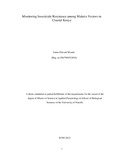| dc.contributor.author | Msami, James Edward | |
| dc.date.accessioned | 2013-07-30T09:21:14Z | |
| dc.date.available | 2013-07-30T09:21:14Z | |
| dc.date.issued | 2013 | |
| dc.identifier.citation | A thesis submitted in partial fulfillment of the requirements for the award ofthe degree of Master of Science in Applied Parasitology in School of Biological Sciences of the University of Nairobi | en |
| dc.identifier.uri | http://erepository.uonbi.ac.ke:8080/xmlui/handle/123456789/52382 | |
| dc.description.abstract | Long Lasting Insecticidal Nets (LLINs) and Indoor Residual Spraying (IRS) are effective
measures of malaria vector control. Pyrethroid insecticides are recommended for use in LLINs
and IRS due to their low mammalian toxicity and fast action. Currently pyrethroid resistance has
been reported in western and eastern Africa, therefore monitoring of resistance is important in all
malaria endemic countries. The overall goal of this study was to monitor resistance levels in
malaria vectors along the Kenyan coast. Susceptibility of malaria vectors to pyrethroids and use
of LLINs was determined in Kilifi, Malindi and Taveta districts of Coastal Kenya. Three sentinel
sites from each district were selected and mosquitoes were sampled from each sentinel site in the
three districts. The collected Anopheles mosquitoes were reared to adults in the insectary. Two to
five days old An. gambiae mosquitoes were assessed for resistance levels to Deltamethrin
(0.05%), Lambdacyhalothrin (0.05%), Oichlorodiphenlytrichloroethane (DOT 4%), Bendiocarb
(0.1 %) and Fenitrothion (0.1 %). Knockdown time (KOT) was recorded up to 60 minutes and
maintained for 24hrs post-exposure on 10 % sucrose solution, after which mortality was
recorded. Furthermore, in each sentinel site, a questionnaire on use of LLINs and other antimosquito
tools was evaluated. The susceptibility test showed that mosquito mortality after 24 hrs
for deltarnethrin was 97%, 93.5%, and 100% in Malindi, Kilifi and Taveta, respectively, while
for Lambdacyhalothrin mosquito mortality was recorded at 97% (Malindi), 95.67% (Kilifi), and
97.5% (Taveta). In addition, the study found that use of LLINs was below 80%. This study
revealed development of resistance to deltamethrin and Lambdacyhalothrin in An. gambiae s.l. in
Kilifi, Malindi and Taveta. It is therefore strongly recommended that the impact of this
development on malaria control efforts be closely monitored before this problem becomes
widespread in the East African Region. | en |
| dc.language.iso | en | en |
| dc.title | Monitoring Insecticide Resistance among Malaria Vectors in Coastal Kenya | en |
| dc.type | Thesis | en |
| dc.description.department | a
Department of Psychiatry, University of Nairobi, ; bDepartment of Mental Health, School of Medicine,
Moi University, Eldoret, Kenya | |
| local.publisher | Biological sciences, University of Nairobi. | en |

